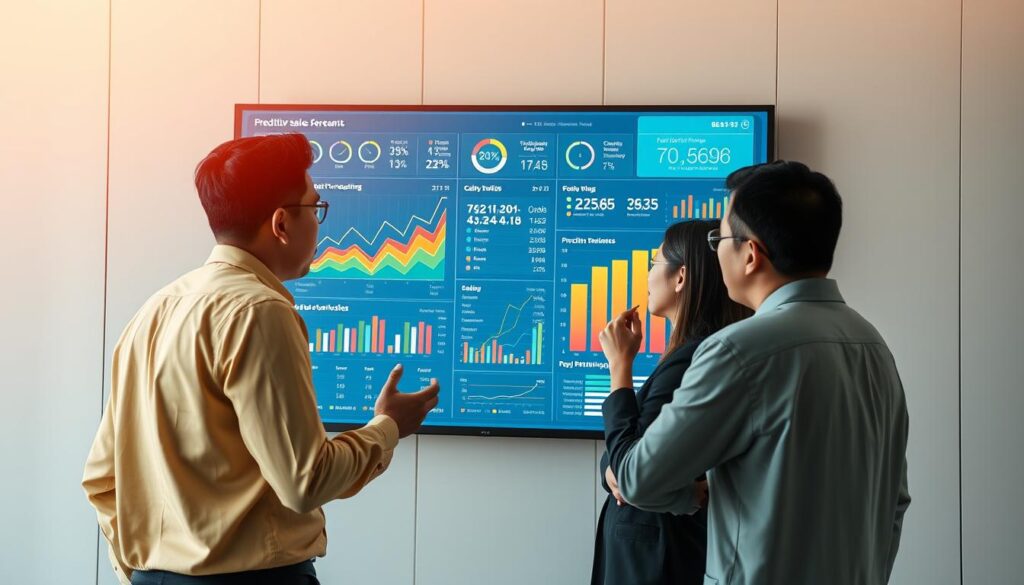Ever wondered why some businesses predict sales with amazing accuracy? Others struggle to keep up. Predictive analytics is key in today’s sales forecasting world. It changes how companies use sales prediction tools and strategies.
Accurate sales forecasts can make all the difference. They can mean the difference between success and just getting by. Knowing how predictive analytics works is essential.
Businesses use past and current data to improve their forecasts. Predictive sales forecasting does more than guess future sales. It helps companies deal with uncertainty and grab opportunities fast.
As competition grows, accurate sales forecasts are more important than ever. Companies using advanced analytics are leading the way.
Key Takeaways
- Predictive analytics makes sales forecasting more accurate, cutting down on old method mistakes.
- Businesses can boost forecast accuracy by 20-30% with predictive analytics.
- Real-time forecasting lets businesses react to market changes in hours.
- Companies see a 10-15% revenue boost after using predictive analytics.
- Spotting seasonal sales patterns can increase sales by 25% during peak times.
Introduction to Predictive Analytics
Predictive analytics uses past data and advanced algorithms to guess future outcomes. It’s a key tool for businesses to make smart decisions. This helps them improve their strategies.
This technology looks at customer behavior and market trends. It’s used in many fields like insurance and finance. For example, insurance companies use it to check if someone is likely to make a claim.
In retail, it helps manage stock and supply chains. This way, businesses can save money by knowing if a product will sell well. They can also make their sales strategies better and please their customers more.
It also uses different methods like decision trees and neural networks. These help with things like finding the best materials and predicting employee turnover. As it gets better, it gives businesses more useful insights.
In today’s world, using predictive analytics for sales is a must for success. It lets businesses predict trends and what customers want. This helps them plan better and stay ahead in the market.
What is Predictive Sales Forecasting?
Predictive sales forecasting is a big step forward in sales strategies. It combines different tools and technologies for better insights. Machine learning algorithms analyze data from various business areas, making sales predictions more accurate.
This method is different from old ways of forecasting. It uses real-time data to adjust forecasts as the market changes. This makes predictions more reliable.
Using predictive sales forecasting can help businesses manage resources better. It also helps set goals and manage inventory more effectively. Companies that use data to predict sales see big benefits.
Studies show that using predictive methods can increase deal closure by up to 45%. This method uses past data and current market trends. It helps sales teams make smart choices.
Real-time sales forecasts are key for adapting to changes. Data from CRM systems and market trends are crucial. But, it’s important to be careful with data quality. Bad data can mess up forecasts.
As companies use predictive analytics, training is vital. It helps teams get the most out of these tools. Companies that have a clear forecasting process see a 35% reduction in errors at first.
There are several sales forecasting methods like linear regression and machine learning. These methods make forecasts more accurate. They help sales teams predict future revenues better.
Adopting predictive sales forecasting helps set clear goals. It also encourages ongoing improvement. This keeps up with the changing world of sales.

The Importance of Accurate Sales Forecasting
Accurate sales forecasting is key to staying competitive in many industries. It helps businesses predict future sales, which affects their revenue. This is crucial for planning resources, like inventory and marketing.
Companies that focus on accurate forecasts see happier teams. This is because realistic sales goals boost morale. It shows how important sales forecasting is for better performance.
Good sales predictions also uncover new market chances. They guide investment and help manage risks from seasonal changes. With precise forecasts, businesses can manage their stock better, saving money and improving demand guesses.
While forecasting can be hard due to time and accuracy issues, tools like Weflow help. They offer features like team forecasting and automated tracking. This makes forecasting more accurate and helps in making better decisions.
Accurate sales forecasting affects many parts of a business. It shows how vital it is in today’s fast-changing market.
| Benefits of Accurate Sales Forecasting | Impacts on Business Operations |
|---|---|
| Improves Resource Allocation | Enhances efficiency in inventory management and hiring. |
| Increases Team Morale | Realistic quotas boost performance and motivation. |
| Identifies Market Opportunities | Guides strategic investment decisions. |
| Manages Seasonal Risks | Helps anticipate fluctuations and adjust strategies. |
| Optimizes Inventory Levels | Reduces excess stock and saves costs. |
How Predictive Analytics Improves Sales Predictions
Improving sales predictions is key for businesses to succeed today. Predictive analytics uses data like past sales, market trends, and customer behavior. This helps make more accurate sales forecasts. Over 67% of sales leaders say it’s harder to make accurate forecasts now than three years ago.
Using machine learning in forecasting can lead to big improvements. For example, a consumer goods company boosted its forecast accuracy from 83% to over 90%. They then refined their models to reach 95% accuracy. This shows how advanced technology can help in the long run.
Predictive analytics does more than just improve forecasts. It can also open up new opportunities for growth. A global fashion retailer saw their market share jump by over 28% and doubled their profit in three years. They improved their forecasting by 15-20 percentage points, leading to better revenue and service levels.
Traditional forecasting methods take weeks and become outdated fast. Businesses need quicker, data-driven solutions. The global predictive analytics market is expected to hit $35.45 billion by 2027. Over 50% of top companies say predictive analytics is crucial for their decisions, showing its value in retail and manufacturing.
Sales forecasting is vital for planning and budgeting. It helps manage inventory and production better. As markets change, using predictive analytics becomes more important. It helps businesses streamline operations and make better decisions.

Key Data Sources for Effective Predictive Analytics
Knowing the key data sources for predictive analytics is crucial for businesses. They need to improve their sales forecasting. By combining CRM and sales data with external market indicators, they can get better results. This mix of data gives a full view of the market and customer behavior.
Integrating CRM and Sales Data
CRM data is essential for predictive analytics. It combines customer data with sales history. This helps businesses find trends and patterns for accurate sales predictions. It lets them:
- Identify customer behavior trends.
- Spot potential churn risks early on.
- Optimize sales strategies based on historical performance.
Also, using these data sources can boost sales forecasting by up to 20%.
External Market Data Considerations
External data adds context to sales predictions. It includes economic indicators, competitor analysis, and industry trends. This data helps businesses understand market conditions and customer preferences. It lets them:
- Anticipate shifting customer demands.
- Adjust sales strategies based on competitive movements.
- Identify growth opportunities in emerging markets.
By mixing internal and external data, businesses get a complete view. This leads to better decision-making. It also cuts down operational costs and boosts marketing campaign results.
| Data Source | Benefits |
|---|---|
| CRM Data |
|
| Sales Data |
|
| External Market Data |
|
Methodologies in Predictive Sales Forecasting
Predictive sales forecasting uses various methods to improve sales predictions. Techniques like statistical modeling and machine learning help understand complex data. These tools help businesses make better decisions and adjust their plans.
Statistical Modeling Techniques
Statistical modeling is key in forecasting. It uses methods like regression analysis to find trends in data. For example, a high correlation between sales calls and successful deals shows its power.
By using these models, companies can forecast sales more accurately. This leads to a 10% chance of higher revenue each year.
Machine Learning Applications
Machine learning has changed sales forecasting. It makes forecasts more accurate, sometimes over 90%. Businesses save 50% of time on data analysis thanks to it.
Machine learning reduces forecast errors by 50%. It’s great for handling large amounts of data.
The table below shows how machine learning differs from traditional methods:
| Aspect | Statistical Modeling | Machine Learning |
|---|---|---|
| Data Utilization | Primarily historical data | Real-time and historical data integration |
| Flexibility | Static models | Dynamic, learning models |
| Analysis Speed | Manual inputs may delay speed | Automation significantly speeds up processing |
| Performance Improvements | Incremental | Potential for major leaps in accuracy |
Combining statistical modeling and machine learning helps companies forecast better. Predictive analytics also helps in better planning and resource use.

Real-World Applications of Predictive Analytics in Sales
Predictive analytics is becoming more popular in Asia. Companies are using it to improve their sales strategies. They show how making decisions based on data can boost sales.
By using predictive analytics, they can quickly adapt to changing markets. This helps them stay ahead in a competitive world.
Case Study: Asian Companies Adopting Predictive Tools
Many Asian companies are leading the way in sales optimization. A big e-commerce site used predictive analytics to improve its marketing. It looked at what customers were browsing and buying.
This led to more customer interaction and higher sales. It was a big success.
A global car maker also used predictive analytics. They forecasted sales in different areas. This helped them plan better and save money.
| Company | Predictive Tool Used | Outcome |
|---|---|---|
| E-commerce Firm | Customer Behavior Analytics | Increased sales and engagement |
| Car Manufacturer | Sales Forecasting Model | Optimized production, reduced costs |
Predictive lead scoring is another tool Asian companies are using. It looks at how potential customers act online and on social media. This makes finding new customers more efficient.
This is different from old ways of scoring leads. Those only looked at basic information.
If you want to learn more about predictive analytics applications, check out these sales case studies. They show how data can change businesses in Asia.
Benefits of Using Predictive Analytics for Sales Forecasting
Predictive analytics in sales forecasting brings many advantages. It boosts the accuracy of sales predictions. Advanced algorithms help analyze data to make forecasts that are 80% or more accurate.
This precision helps businesses make better decisions. They can use resources more efficiently and plan strategies based on predicted market trends.
Improving Sales Prediction Accuracy
Using predictive analytics can improve sales accuracy by up to 30%. This leads to better planning and adjustments in sales tactics. It keeps businesses competitive in a changing market.
Sales teams with predictive tools can focus on the most promising leads. This results in a 10% increase in sales efficiency and a 20% boost in sales performance.
Enhancing Customer Understanding
Predictive analytics helps understand customer behavior. It identifies valuable customer segments for better marketing and personalized experiences. Companies that use it see a 30% increase in customer satisfaction and a 10-20% increase in customer lifetime value.
These insights help businesses meet customer needs, reduce churn by 25%, and build lasting relationships.

| Metrics | Impact of Predictive Analytics |
|---|---|
| Sales Forecast Accuracy | Improvement up to 30% |
| Sales Performance Increase | Reported 20% boost |
| Lead Scoring Conversion Rate | 15% increase |
| Customer Retention Improvement | Potential 25% reduction in churn |
| Sales Efficiency | 10% increase |
| Customer Satisfaction | 30% increase |
Predictive analytics empowers businesses to serve their customers better and improve forecasting. Accurate predictions and deeper customer insights lead to growth and loyalty. This sets the stage for long-term success.
Challenges in Implementing Predictive Sales Forecasting
Businesses face many hurdles when trying to use predictive analytics for sales forecasting. One big problem is data quality. Bad or missing data can ruin any predictive model, leading to bad decisions and wasted money. Studies show that about 40% of business projects fail because of these data issues.
Another challenge is finding skilled people to work with predictive models. The lack of trained professionals makes it hard for companies to use these systems well. This talent gap makes it tough for businesses to succeed in today’s fast-paced market.
High costs are also a big challenge. Companies might not want to spend money on new technologies, even if they could improve things like inventory management and customer happiness. Without enough money, businesses can’t use predictive analytics as much as they could.
The complexity of predictive forecasting algorithms is another problem. Many businesses struggle to understand and use advanced machine learning models. This makes it hard for some companies to use predictive sales forecasting to its full potential.
| Challenges | Impact | Potential Solutions |
|---|---|---|
| Data Quality Issues | Inaccurate forecasts, wasted resources | Invest in data cleansing tools and training |
| Skilled Personnel Shortage | Underutilization of analytics tools | Upskill existing employees or hire data specialists |
| High Implementation Costs | Delayed adoption of advanced systems | Assess long-term ROI and prioritize investments |
| Algorithm Complexity | Inability to leverage predictive models | Utilize user-friendly predictive analytics software |
It’s important for businesses to tackle these challenges to make the most of predictive analytics. By finding good ways to manage these issues, companies can get valuable insights and improve their sales forecasting.
Conclusion
The world of sales forecasting is changing fast with predictive analytics. Even though over 80% of companies have missed their sales targets, new tools are helping. These tools use predictive analytics to give accurate insights.
Businesses can now find new ways to improve their strategies. This leads to meeting targets more often.
Looking ahead, companies that use historical data and advanced models will lead. Traditional methods often fail, leading to big mistakes in sales predictions. But, predictive analytics makes these forecasts better.
This leads to smarter planning and using resources well. Companies can better understand what customers want and market trends. This helps them manage their stock and connect with customers better, leading to growth.
To stay ahead in changing markets, using predictive analytics is key. It helps businesses deal with unknowns by changing strategies early. So, moving towards accurate sales forecasts is not just about tech. It’s a smart move that can shape a company’s future and help it face challenges.

